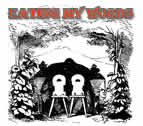![]()

“A little garlic?” my father used to object. “There's no such thing as a little garlic.” Eaten raw, he had a point. Elizabeth David warned that “half a clove crushed into the dressing has a more penetrating aroma than a 1/2 pound stewed with a chicken.”
Raw garlic was the food of strong smelly peasants. The Egyptian pyramid builders, Greek athletes, Roman legionaires and harvesters guzzled it like popcorn; they were thought to gain prodigious power and endurance, though at the cost of perpetual ostracism.
Or worse. In the Arabian Nights, when a certain young man came to his bride smelling of garlic, she ordered him to be bound, and cut off his two thumbs and two great toes, for presuming to appear before her without having purified his fingers. Ever after this he always washed his hands [Editor: as best he could] one hundred and twenty times with alkali and soap after partaking of garlic in a ragout. (Brewer, The Reader's Handbook, 1880)
Even kings could be saved or damned by its potency. The infant Henri de Navarre was protected from the plague at birth by having garlic rubbed upon his lips, but it seems to have become habit forming. When the young Henry IV-to-be came to Paris his odoriferous penumbra announced his arrival and his bride, Marguerite de Valois, refused on at least one occasion to share his mephitic bedchamber.
TODAY, garlic-lovers need no longer lose their darlings or their digits. Medical researchers, who have canonised the Mediterranean diet of olive oil, whole-grain pasta, fresh fish and—bless them!—red wine, have found that raw garlic may not only reduce cholesterol, but also help to inhibit the blood-clot formation that leads to strokes and hardening of the arteries. Better still, the substance responsible is allicin, the very compound that makes garlic an offensive weapon. Scientists have thus welcomed the barbarians with open arms, invited them into the kitchen, and created the Macho-Foodie.
Macho-Foodies may be sadists (raw garlic eaters) or masochists (chili eaters). Both foods are ticking time bombs. Throughout history, garlic chewers have been shunned for fear of the double whammy; as for chili, it is axiomatic that a good vindaloo burns twice.
But Macho-Foodism is really indivisible. The most lethally garlic-intensive rouille is incomplete without a mouth-searing shake of cayenne; a self-combusting bowl of chile con carne minus the garlic is merely pain without pleasure. Like other suffering heroes through the ages, the Macho-Foodie demonstrates his virility both by the agony he endures and by the potency of his presence.
I knew this, sort of, by the age of seven. Growing up a Puritan in a Portuguese fishing town on Cape Cod, I watched the other kids gobble up stinky stews that brought tears to their eyes. At home I was admonished over the clam chowder that garlic and “hot peppers” made you smell bad and nice people did not eat them. Years later, via Howard Mitcham's wonderful Provincetown Seafood Cookbook, I would discover at last the forbidden pleasures of vinha d'alhos and molho tomate.
The affaire de cuisine of garlic and chili has produced a whole family of macho cook books, of which the most flamboyant is Judith Choate's HOT! The Cookbook For Passionate Devotees Who Go Bonkers Over The Incendiary Pleasures of Food That Never Stops Whamming, Popping, or Zapping. Of sixty-five primary recipes, over forty include garlic, often raw and usually tossed in by the crushed tablespoonful. The graphics are as purple as the prose, but the recipes are for zealots and offer no short cuts, demanding primary ingredients and loving, tearful attention.
Recipes with garlic warn against frying it for long, lest it turn bitter. There are exceptions. Rick Bayless, food scholar, founder of the great Chicago Mexican restaurant Frontera Grill, and author of Authentic Mexican, gives a recipe for Pescado al Mojo de Ajo, fried fish with ten garlic cloves thinly sliced and toasted slowly in oil and butter until golden brown. This is closely related to the classic Basque method of preparing red sea-bream, as described by Elizabeth Lambert Ortiz in The food of Spain & Portugal.
AFTER a macho-feast, I often do penance with lettuce and cottage cheese. To get my fix, I smother it in a raw blender-sauce made of a fat clove of garlic, balsamic vinegar, anchovy essence, capers, olive oil, a tomato, and a vigourous application of Tabasco sauce. I lunch alone . . .
The eater of cooked garlic is not a Macho-Foodie; the odoriferous, health-giving allicin has been driven off. In Provence, Ford Maddox Ford tells of a glamourous model who was “one of the best cooks in London”. She loved garlic, “as must all good cooks”, but the intimacy of her work forbade it. She grew desperate. In an act of bravado, she made and consumed an entire Poulet Bearnais, in which a chicken is immolated on a kilo of “the sacred herb”. Her breath remained sweet; only her greengrocer knew her guilty secret.
Today she could come out of the larder. Gilroy, California, “Garlic Capital of the World”, has an annual Garlic Festival where they gobble it up by the shovel-full. They would take right kindly to my recipe for Sorbet Diabolique. Serve it up as a tourment goule between the guacamole and the chiles rellenos, and get out of town fast.
1 ample garlic bulb, separated and peeled
1 tsp (more or less) Tabasco sauce
1 litre tomato juice
1/2 tsp sugar
1/4 teaspoon salt
1 dash of Worcestershire sauce
1 splash of vodka or gin
Liquidise. If your blender is small, reserve some of the tomato juice and stir in separately. Freeze in an ice cream maker and store in a lead-shielded container. Welcome to the club.
©1996 John Whiting